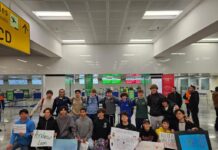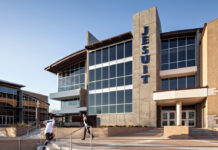 It’s a warm and humid day in Nicaragua, dozens of elementary school children have gathered for a brand new day of school. However, when they arrive, they find an assortment of over 20 young men ranging from 14 to 18 years old and of every kind of ethnicity and physique. The kids introduce themselves to the Jesuit guys who have volunteered to paint their school. Needless to say, the children immediately start fawning over their new friends. All of a sudden, little kindergartners and early grade-schoolers are hopping on guy’s backs as they run up and down the schoolyard, jumping and giving piggy back rides to their new little friends.
It’s a warm and humid day in Nicaragua, dozens of elementary school children have gathered for a brand new day of school. However, when they arrive, they find an assortment of over 20 young men ranging from 14 to 18 years old and of every kind of ethnicity and physique. The kids introduce themselves to the Jesuit guys who have volunteered to paint their school. Needless to say, the children immediately start fawning over their new friends. All of a sudden, little kindergartners and early grade-schoolers are hopping on guy’s backs as they run up and down the schoolyard, jumping and giving piggy back rides to their new little friends.
During the first week of July, Mr. Rich Perry, community service director at Jesuit, led more than twenty students on the 2013 Nicaragua Mission Trip. They helped a local school and an organic farm, hiked up a volcano, and met up with Jesuit students in Nicaragua from Colegio Centro América and Instituto Loyola, the two other Jesuit high schools located in Managua, the capital of Nicaragua.
On Monday, day 1 of the 2013 Nicaragua Mission Trip, the group enjoyed a full day of team building on Mombacho Volcano, one of Nicaragua’s many beautiful active volcanos. The bus drove to about halfway up the forested volcano, and then the group transfered to a specialized open-roofed bus to finish the drive up the moist mountain side. When the group nearly reached the top, the bus stopped, and the arduous trek up to the second highest peak began.
After finishing a nearly three hour hike to the second highest peak. and drinking what seemed like hundreds of gallons of water, the group departed to return to the half-way point to eat a traditional Nicaraguan lunch and to rest before the most exhilerating part of the day, zip-lining on Mombacho. The zip-line course included eleven stations, one of which was attached to a tree where howler monkeys lived. Reflecting on the day’s experiences, Mr. Keith Reese and Conner Kerl described the hike as “rewarding” and loved the excitedment of ziplining. With the the day far into the afternoon and the group transformed into a tight team, the students and faculty returned to their hotel on the Apoyo Volcanic Lagoon.
point to eat a traditional Nicaraguan lunch and to rest before the most exhilerating part of the day, zip-lining on Mombacho. The zip-line course included eleven stations, one of which was attached to a tree where howler monkeys lived. Reflecting on the day’s experiences, Mr. Keith Reese and Conner Kerl described the hike as “rewarding” and loved the excitedment of ziplining. With the the day far into the afternoon and the group transformed into a tight team, the students and faculty returned to their hotel on the Apoyo Volcanic Lagoon.
The main purpose of the trip was to help Escuela Maria Auxiliadora Niquinohomo, a small elementary school in a town outside of Managua, the capital of Nicaragua. The school had seen many years of wear and tear so the Dallas visitors helped by raising money to buy them proper bathrooms and by repainting the school. The Jesuit volunteers spent 3 long days in the sun painting the school.
Of course, some time was devoted to playing with the children. Jesuit students ran them back on forth on our shoulders, played keep away soccer, and played hide and go seek. After the work was finished, the children and staff of the school showed their appreciation by dancing and singing for us in a school-wide celebration.
On Wednesday, day 4 of the Mission Trip, the group woke up early to travel to an organic farm about ten minutes away from any paved roads on what the locals call moto-taxis. There, the mission group learned that the organic farm specializes in instructing people living in rural areas how to support their families by efficiently using their land. The students and faculty fed and milked goats, washed pigs, fed rabbits, and shoveled animal waste which was eventually used to make manure for the plants. When all the tasks were finished, the farm’s director gave a presentation on how his mission not only helped humans but also fulfilled his task of being a steward of creation. With this knowledge, the group gave a farewell and departed to meet Insituto Loyola and Colegio Centro América.
Thursday, day 5 of the trip, the group went to Colegio Centro América to play various sports such as volleyball, basketball, and soccer. After about an hour of playing volleyball and basketball with the Colegio Centro América students, the students from Instituto Loyola showed up  and everyone had a big game of fútbol. Almost right as the game started, it began to rain. With little traction in their tennis shoes, the American Jesuit students began to slip and slide. However, by fighting hard, they were able to keep up. The first half was fierce as neither team managed to score a point. But come the second half the Nicaraguan Jesuit schools switched out, pitting fresh new players eager to show their skills to the tired and muddy Americans. It wasn’t long before the Nicaraguan players managed to outmaneuver the Americans and score their first goal. And from there, it went downhill. They managed to score twice more before Junior Nick Pace, Jesuit soccer player, switched in as goalie and managed to block every shot afterwards. After the switch, it went back to a stalemate, ending the game with no more goals at 3-0. After the game, the guys and girls from the various schools started talking and hanging out. The language barrier seemed to be nonexistent as they spoke with ease to one another. Overall, the relationship between Jesuit schools was astounding. Mr. Reese, Jesuit theology teacher and chaperone for the trip, commented that one of his favorite parts was “how well the schools got along.”
and everyone had a big game of fútbol. Almost right as the game started, it began to rain. With little traction in their tennis shoes, the American Jesuit students began to slip and slide. However, by fighting hard, they were able to keep up. The first half was fierce as neither team managed to score a point. But come the second half the Nicaraguan Jesuit schools switched out, pitting fresh new players eager to show their skills to the tired and muddy Americans. It wasn’t long before the Nicaraguan players managed to outmaneuver the Americans and score their first goal. And from there, it went downhill. They managed to score twice more before Junior Nick Pace, Jesuit soccer player, switched in as goalie and managed to block every shot afterwards. After the switch, it went back to a stalemate, ending the game with no more goals at 3-0. After the game, the guys and girls from the various schools started talking and hanging out. The language barrier seemed to be nonexistent as they spoke with ease to one another. Overall, the relationship between Jesuit schools was astounding. Mr. Reese, Jesuit theology teacher and chaperone for the trip, commented that one of his favorite parts was “how well the schools got along.”
On the last day of the trip, to reward themselves and reflect on their service to the rural communities of Nicaragua, the mission group drove to a small and furious beach on the Pacific coast named La Boquita. Here the group ate seafood, swam in the cold and foamy Pacific water, and relaxed in hammocks before returning to their last hotel, The Hotel Plaza Colón in the colonial city, Granada.
 When asked if he would do the trip again, Connor Kerl ’15 simply replied “definitely.” He went on to say that he really enjoyed “meeting the other students from Loyola and Colegio Centro América and playing games with them,” and although some things such as the hiking were difficult, “they were challenging yet rewarding.” Overall, Connor said that he really hoped to do it again if he got the chance.
When asked if he would do the trip again, Connor Kerl ’15 simply replied “definitely.” He went on to say that he really enjoyed “meeting the other students from Loyola and Colegio Centro América and playing games with them,” and although some things such as the hiking were difficult, “they were challenging yet rewarding.” Overall, Connor said that he really hoped to do it again if he got the chance.
Mr. Tim Murphy, Jesuit Basketball coach and chaperone on the trip had this to say: “The Nicaragua trip
 is one of my favorite things I have done here at Jesuit. It was special to me because it was my first mission trip and the relationships that we developed over the 8 days are something that I will not forget. We are actively looking into going back next summer and possibly expanding the program. We want to work with villages much like the ones in Niquinohomo. We also want to maintain our relationships that we started to build this June with the Jesuit school in Managua and also the school in Niquinohomo.”
is one of my favorite things I have done here at Jesuit. It was special to me because it was my first mission trip and the relationships that we developed over the 8 days are something that I will not forget. We are actively looking into going back next summer and possibly expanding the program. We want to work with villages much like the ones in Niquinohomo. We also want to maintain our relationships that we started to build this June with the Jesuit school in Managua and also the school in Niquinohomo.”
Impressed with the astounding growth that the project has seen, Mr. Perry commented that they might even need to split the group “into two separate weeks.” Already, eager students and parents are contacting Mr. Perry, asking when they can sign up for the next trip. Twenty-four students went on the trip this year, and Mr. Perry sees the potential for more than one trip a year, commenting that all of the students “were just awesome,” and that he felt that they reflected the qualities of Jesuit students. Also, he’s seen a “high level of interest form different staff members,” meaning that the trip will continue to see positive growth.
By having multiple trips, Mr. Perry is “looking for something that is long term.” The expression he used was that “We’re looking for a deep well not a shallow one.”
All in all, the trip was a great success! All of the Jesuit students acted in a fashion that properly represented Jesuit and formed ties with the schools in Nicaragua! This was the fourth year of the trip and its success has been a great milestone for the community service trips as a whole!






